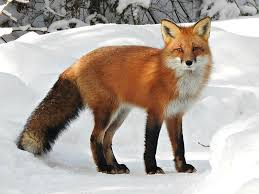Ok let’s have a look at the red fox which I think may be the
most well know of foxes it is in my opinion a handsome looking creature.
It is the largest of the true foxes and one of the most widely
distributed members of the order Carnivora, being present across the entire
Northern Hemisphere including most of North America, Europe and Asia, plus
parts of North Africa.
They have long snouts and
red fur across the face, back, sides, and tail. Their throat, chin, and belly
are grayish white. Red foxes have black feet and black-tipped ears that are
large and pointy. One of the most noticeable characteristics of the red fox is
the fluffy, white-tipped tail.
They have been called bold,
cunning, and deceitful, particularly in children's stories. In fact, they are
shy, secretive, and nervous by disposition, and they appear to be very
intelligent.
They are extraordinarily opportunistic, omnivorous predators.
Nonetheless, most studies agree that they feed predominantly on small mammals,
particularly rodents (rats, mice, voles and the occasional squirrel) and
lagomorphs (rabbits and hares); in rural areas these groups together typically
account for about 50% of the diet.
Red foxes are the most widespread wild canid and have the
largest natural distribution of any non-human land mammal.
Red foxes can be found in many countries, including, most of
Europe, Russia, Kazakhstan, Iraq, Iran, Pakistan, northern India, China, and
Thailand. They can be found in the northern and eastern United States, north
through Canada and Alaska to Baffin Island. In parts of North Africa as
well as here in Australia they were introduced to Australia in the 1800s and
have spread throughout much of the country. However, it wasn’t till the
late 1990’s that they were introduced to Tasmania.
They are hunted for sport and for their pelts. Red foxes
are also the primary carrier of rabies in much of their range
Both the male and female red fox, care for their pups, or kits. The mother, or vixen, spends a lot of time grooming and cleaning the cubs. The father brings food to the mother during the first few weeks. The parents take turns hunting and bringing food back to the kits.
The vixen gives birth to 1–10 or more pups in a den, which is
often a burrow abandoned by another animal. The pups are born brown or
gray, but usually grow a new red coat by the end of the first month.
Their dens are usually located on the edges of forests, near
fields, or under porches.
The pups start playing outside the den when they are about a
month old. The mother feeds them regurgitated food at first, but
eventually brings them live prey to play with and eat.
The young remain with their parents at least until the fall of
the year they were born in. They disperse in the fall once they are fully grown
and independent.








OH I love them really. They are so beautiful. I seldom get to see one but consider it a great day when I do.
ReplyDeleteThey are indeed beautiful
DeleteWe have red foxes in Georgia - I have seen them in the neighborhood!
ReplyDeleteThat is cool, I have never seen one myself
DeleteThe are the most handsome of the foxes, I think. :)
ReplyDeleteI think you may be right
DeleteThey are quite common here and have adapted well to human settlement. Better keep your cats indoors though!
ReplyDeleteYeah I think you may be right about the cats
DeleteGorgeous critters ... and the babies are so darn cute!!!
ReplyDeleteI agree
DeleteFoxes are such gorgeous and clever animals, Jo-Anne. Who wouldn't love to see them?
ReplyDeleteStrange people that's who
DeleteHe's a beautiful fox. Wow, they are in a lot of countries. That is sweet how they both take care of their pups. Thank you for sharing. Have a great day.
ReplyDeleteI didn't know they were is so many counties, thanks for dropping by
Delete